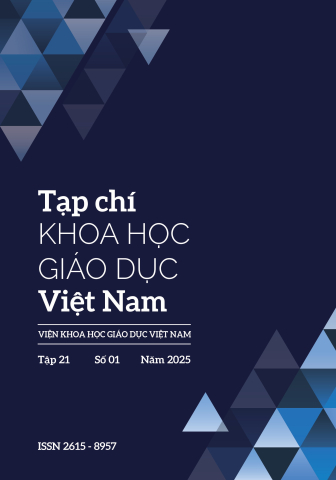[1] Thủ tướng Chính phủ, (25/01/2022), Quyết định số 131/ QĐ-TTg về việc Phê duyệt Đề án “Tăng cường ứng dụng công nghệ thông tin và chuyển đổi số trong giáo dục và đào tạo giai đoạn 2022 - 2025, định hướng đến năm 2030”
[2] Bộ Giáo dục và Đào tạo, (31/08/2023), Công văn số 4771/BGDĐT-CNTT về việc Hướng dẫn thực hiện nhiệm vụ ứng dụng công nghệ thông tin, chuyển đổi số và thống kê giáo dục năm học 2023 - 2024.
[3] Simon, M, (2014), Is Blended Learning the Future of Higher Education? A discussion of MOOCs, Gamers, Connectivists’ and Sceptics, Studies of regional policy, 17(1), p.67-91.
[4] Garrison, D. R., & Vaughan, N. D, (2008), Blended Learning in Higher Education: Framework, Principles, and Guidelines, San Francisco, CA: Jossey-Bass.
[5] Heather Staker – Michael B. Horn, (2012), Classifying K-12 Blended Learning, Innosight Institute.
[6] Hockly, N, (2018), Blended Learning, ELT Journal, 72 (1), p.92-101, Doi: 10.1093/elt/ccx058.
[7] N. D. Nguyen and T. T. Nguyen, (May 2020), Blended Learning application in citizen education teachers training activities, Vietnam Journal of Education, No. special period 1, pp.216-220.
[8] T. H. Tran and T. K. O. Nguyen, (2020), Basic principles for designing university courses according to effective Blended learning model, Journal of Education, no.477, pp.18-22.
[9] https://elearningindustry.com/6-blended-learning models-blended-learning-successful-students (Update 12 February 2016).
[10] Graham, C.R., (2006), Blended Learning Systems: Definition, Current Trends, and Future Directions. In: Bonk, C.J. and Graham, C.R., Eds., Handbook of Blended Learning: Global Perspectives, Local Designs, Pfeiffer Publishing, San Francisco.
[11] Alammary, A. S., Sheard, J. I., & Carbone, A., (2014), Blended learning in higher education: Three different design approaches, Australasian Journal of Educational Technology, 30(4), pp.440 – 454, https:// doi.org/10.14742/ajet.693.
[12] Driscoll, M, (2002), Blended Learning: Let’s Get beyond the Hype, IBM Global Services.
[13] Oliver, M., & Trigwell, K, (2005), Can ‘Blended Learning’ Be Redeemed? E-Learning and Digital Media, 2(1), pp.17–26, https://doi.org/10.2304/ elea.2005.2.1.17.
[14] Walters, B., (2008), Blended learning-classroom with on-line, The CALSCA Online Magazine.
[15] Nguyễn Hoàng Trang, (9/2020), Dạy học kết hợp và tổ chức dạy học kết hợp tại trường trung học phổ thông, Tạp chí Giáo dục, số 485, kì 1, tr.33-38.
[16] Thủ tướng Chính phủ, (03/6/2020), Quyết định số 749/ QĐ-TTg về việc Phê duyệt Chương trình chuyển đổi số quốc gia đến năm 2025, định hướng đến năm 2030.
[17] Bộ Giáo dục và Đào tạo, (10/5/2022), Quyết định số 1282/QĐ-BGDĐT về việc ban hành Kế hoạch tăng cường ứng dụng công nghệ thông tin và chuyển đổi số trong giáo dục và đào tạo giai đoạn 2022 -2025.
[18] Bộ Giáo dục và Đào tạo, (2018), Chương trình Giáo dục phổ thông môn Toán.
[19] Charles R. Graham, (2009), B-Learning Moddle E-Learning, Brigham Young, University.
[20] Graham C. R, (2013), Emerging practice and research in blended learning, In I. G. (Ed.), Handbook of distance education 3rd ed, pp.333–350, New York, NY: Routledge.
[21] Nguyễn Bá Kim, (2011), Phương pháp dạy học môn Toán, NXB Đại học Sư phạm, Hà Nội.
[22] https://unesdoc.unesco.org/ark:/48223/pf0000245745_ vie (Year of publication: 2016).


